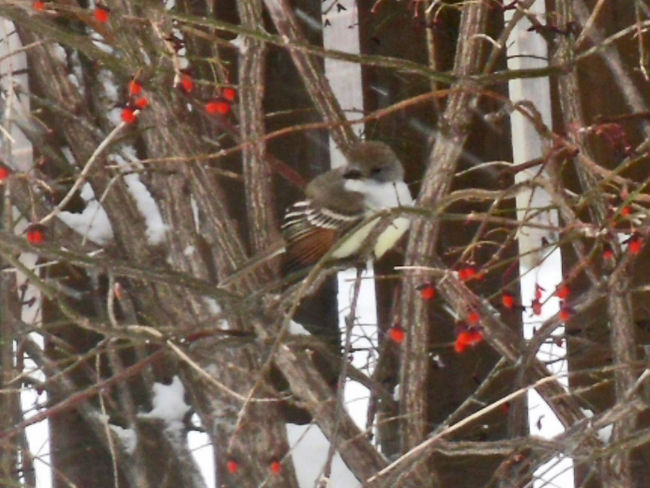
© Darlene DeemertAn ash-throated flycatcher is shown in a Barrie backyard Nov. 18.
If you were a bird, you may want to consider flying south in October and not returning to our area until next May. Many human snowbirds do just that. Many birds migrate south to warmer climates for winter, then return in the spring, but some seed-eating birds tough out the winter with us.
There is a family of birds called flycatchers that survives by hawking flying insects out of the air in mid-flight. There are not many insects flying around in winter, so a flycatcher that tried to overwinter instead of migrate would have little chance of survival.
Flycatchers mainly eat insects and other invertebrates, but also fruit.
One of the largest and most common species of flycatcher that nests in our area in summer is the great-crested flycatcher. It is a member of the Myiarchus genus and the second-largest flycatcher in our area, slightly smaller than the eastern kingbird. Great-crested flycatchers leave our area in late summer and early fall to fly south to southern Central America or northern South America.
There are few records of this species staying around in late fall or winter in our area.
Great-crested flycatchers mainly eat insects but will also eat a good amount of fruit, which they swallow whole, then regurgitate the pits. The one member of the flycatcher family that leaves later than most and arrives back in our area in late March is the eastern phoebe. It winters in the southern United States and Mexico. It eats mainly insects, but survives long periods on small fruits and seeds when they are unable to find insects.
Imagine the surprise when Barrie resident Darlene Deemert saw a flycatcher drop from the sky into her small residential backyard near the Barrie Country Club at about 2 p.m. Nov. 18, in the middle of a snowfall.The bird looked like a great-crested flycatcher, but smaller, and didn't have the grey throat and breast along with the deep yellow belly of a great-crested flycatcher. The throat and breast was white and the belly was a washed-out, light yellow colour.
She checked her bird guide and the bird looked like an ash-throated flycatcher known only to nest as far north as northern California and winter in Mexico and Central America.This is not a bird one would expect to see in Ontario, especially in the middle of a snow storm in mid-November. She then wondered if it could be a young great-crested flycatcher that did not migrate with the rest of the species a few months ago. She captured a few distance photos of the bird with her camera and posted her observation on my Simcoe Nature Board website.
Although still considered rare, they predictably appear on the East Coast from Florida north to the Atlantic provinces from early November to mid-December. In fact, during this season, one is more likely to encounter an ash-throated flycatcher on the East Coast than a great-crested flycatcher that departs from our area in early October.
This bird stayed in Deemert's backyard flying around a low burning-bush shrub loaded with berries in company with a small flock of juncos that were visiting a feeding station and millet and sunflower seeds. She saw it flying up from the bush and catching snowflakes in midair like they were flies for about 30 minutes. Then, it flew away with a flock of juncos.
It was not seen again, but the following morning, a number of us checked the area unsuccessfully for signs of the bird since it would be a new species for our Simcoe County and even Ontario personal lists. There were no further reports received in the following days.
The ash-throated flycatcher is a rare but regular vagrant to the East Coast and individuals have been recorded nearly every year in all the coastal states and provinces, with inland sightings being less in the east and midwest.
Comment: Maybe some change in the planet's environment is interfering with this bird's ability to correctly utilise the Earth's magnetic field to navigate by? See also this: Animal Magnetism: How the magnetic field influences animal navigation
Extract - Then again, perhaps any magnetic changes of a natural kind may also play a role? Earth's magnetic field is weakening 10 times faster now